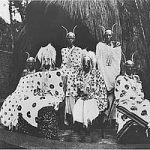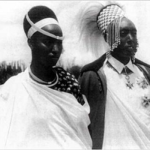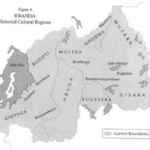The Eruption Of Vilence
In the historical data we have noted the success with which the peripheral areas had withstood the attempted incursion of the traditional power structure of central Rwanda up to the time of colonial rule. We have also noted that with the support of the colonial administration Tutsi chiefs were imposed on the peripheral areas. In these areas we have to consider not only the effect of the monopoly of political power by a limited number of Tutsi lineages, forming the Tutsi aristocracy of these regions, who have the backing of an external power and whose abuses of political power cannot be effectively checked, but also the fact that these powerholders had been recently introduced by force into areas which had hitherto maintained their political independence from central Rwanda.
In addition these new and alien political agents had, ex officio, access to land in these areas. This is of particular importance in relation to the fact that these areas were the most densely populated in Rwanda, that the land had been most recently claimed from the forest zones and that no new areas were available. Furthermore landholdingwas directly related to the powerful lineagegroups. Thus political domination resulted in a slowbut steady movement of settlers from central Rwanda intothese areas, the settlers being kinsmen of the politicalchiefs.
In the peripheral areas there thus arose a clear identification between the central Rwanda power structure, the comparatively recent introduction of Tutsi in positions of political power in these areas and the progressive occupation of land by Tutsi. Moreover the way in which the new rights over land were exercised was contrary totraditional patterns of allocation and occurred among alocal population which was almost exclusively Hutu. On this basis conceptual categories of indigenous Hutu as opposed to alien, colonising and land occupying Tutsi were established.
The pre-existing tensions between the peripheral areas and central Rwanda had been controlled by the presence of the Belgian administration which protected the colonizing group. However the existence of these tensions made for a greater awareness of common identity within each group.
Because of the particular composition of the new power-holding and infiltrating group, this identity was not expressed in categories based on a regional basis – such as northerners and southerners – but rather in ethnic terms referring to groups of people.
It is not within the scope of this pont of view to describe and analyse all the factors which contributed to the revolt that took place around 1960 as not only not all the data are available but also the assessment of factors such as the personalities of the leaders or the influence of the events in the former Belgian Congo during the period leading up to independence, belong to a different discipline. The period of violent clashes lasted for several years from November 1959, starting with a violent anti-Tutsi revolution in the peripheral areas of the North and North-West. This was followed by a violent reaction of certain Unar leaders in the centre of Rwanda,We will be primarily concerned with the first violent revolt of 1959 and its subsequent reactions, considering later violence over the years 1960 to 1964reactions or counter-reactions to the initial revolt which set the pattern of violence laden climate of these years. However as will be demonstrated, the violence must be seen as an expression and culmination of the conflict situation which had arisen.
The first eruption of violence took place as a result of an incident which occurred on first of November 1959,some miles from Kabgayi in central Rwanda. Some Tutsiyouths, none of whom were armed, confronted one of the fewHutu subchiefs who was also one of the principal exponentsof the new Hutu political movement. They teased him about his new found importance and a few blows were exchanged.The rumour spread that the subchief had been hilled and theHutu of Ndiza, not the local people from thesubchief’s village, took to arms. The Hutu in the North,North-West and South-East started a campaign of drivingTutsi from their homes, burning their huts and destroyingtheir plantations. Quotations from the report of theBelgian Parliamentary commission illustrate the issues and stress the locus of the revolt:
« Ce fut dans le Nord du Rwanda que les destructions opérée par les Hutu furent les plus importantes.Les Tutsi y étaient considérés comme des intrus qui s’étaient appropriéle sol et continuaient à le faire. En Territoire de Ruhengeri les Hutu semblaient bien décidés à n’épargner aucune habitation Tutsi et a dégoûter les Tutsi àtout jamais de s’établir dans la region ». (C.R.I.S.P, 1961 p.150)
Up until the sixth of November the Hutu action had been confined to the northern areas. On that day about two hundred northerners went down intoKibuye (Central Rwanda)
“brûlant parmi les cases abandonées, celles qui leur semblaient appartenir aux Tutsi. II y eut de nombreuses erreurs. Les incendiaires semblent avoir détruit principalement les cases dont 1’aspect indiquait une certaine aisance chez leur propriétaire »
The same day however the group was repelled,
« La population hutu et Tutsi attendit les incendiaires et les attaqua. Ce fut un veritable massacre ».
In this counter-action at least fifty eight people died, all of whom were from the North (Kingogo and Ndiza).
This counter-action involving the defence of the people of Kibuye against the northern incendiarists was immediately followed by the systematic arrest of certain Hutu leaders in the centre of Rwanda, some of whom were killed. This was done on the orders of certain members of the Supreme Council who were at the same time the leaders of the Unar party. Their orders were executed by the army and the Twa.
The Supreme Council members justified this action on the grounds that the Belgian administration had failed to maintain law and order and failed to punish the instigators, as they put it, of the revolt in the North. In the stated opinion of the Supreme Council members, the Hutu leaders had been responsible for the violence in the North. Thus it is clear that the revolt started and spreadunopposed in one of the peripheral areas where Tutsi political control was weakest since their incursion into the area had been most recent. It occurred also in an area where a pattern of government, identical to that of central Rwanda, had been introduced by the colonial power. Both the specific events and the location of the conflict clearly indicate that the revolt was primarily a violentattempt at liberation from the political and economic control and infiltration of central Rwanda. The fact that it took only a false rumour to spark off the violent revolt in the North can only be understood when seen against the background of factors underlying the specific latent conflict situation contained in the opposition of the peripheral areas to central Rwanda, the context of the wider conflict
situation with reference to Rwanda as a whole and the total absence of channels for the effective expression of popular opinion in political terms and of avenues for the redress of grievances .
The violent counter-reaction of the leaders of the Unar party, who were at the same time members of the Supreme Council, against some ofthe Hutu leaders had two direct results. It provided the Hutu leaders with the occasion to close the ranks between the Hutu of the North and the Centre, as the arrests and killing in the Centre were explains as ultimate proof of anti-Hutu sentiment among the Unar party chiefs and the extent to which they would go, i.e. the elimination of Hutu leaders to prevent the reforms demanded.
The Unar party, which was the visible organisation of the Tutsi aristocracy, became the visible enemy of all Hutu. Another direct result was the imprisonment of the Unar leaders by the Belgian administration. Some however managed toescape abroad and continued their political activities fromoutside the country. When the king left the country to assist at the independence celebrations of the former Belgian Congo, the minister of the Colonies in Brussels decided that he should stay outside the country until the people had expressed their wish in a plebiscite on the continuation of the monarchy.
https://uk.amateka.net/the-eruption-of-vilence/https://uk.amateka.net/wp-content/uploads/2019/11/rd10.jpghttps://uk.amateka.net/wp-content/uploads/2019/11/rd10-150x150.jpgHistory of kingsSocial & cultureIn the historical data we have noted the success with which the peripheral areas had withstood the attempted incursion of the traditional power structure of central Rwanda up to the time of colonial rule. We have also noted that with the support of the colonial administration Tutsi chiefs were imposed on the peripheral...BarataBarata rpierre@ikaze.netAdministratorAMATEKA | HISTORY OF RWANDA




